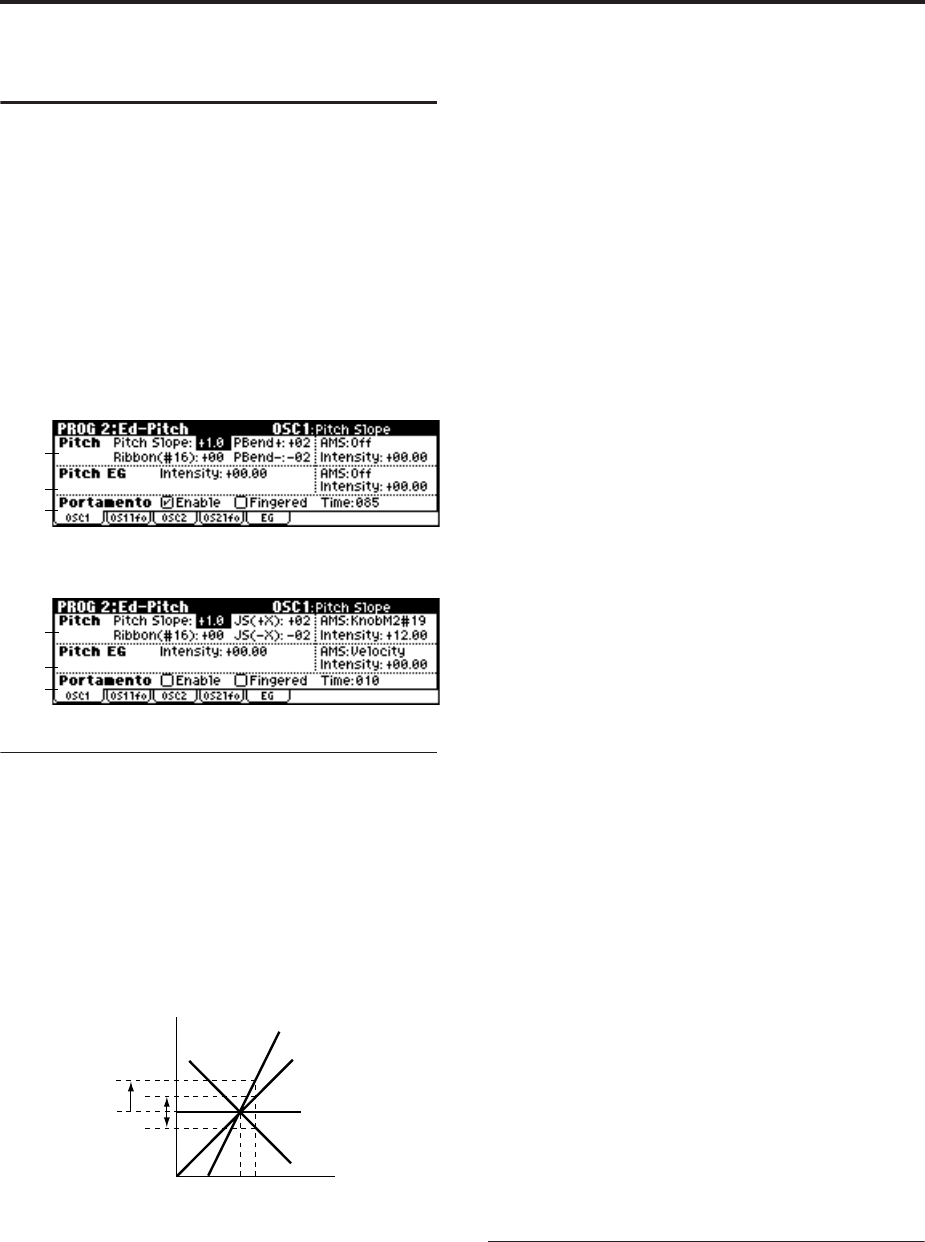
10
PROG 2: Ed–Pitch
Here you can make pitch modulation settings for oscillators
1 and 2.
2–1: OSC1
Specifies how the key position (on the keyboard) will affect
the pitch of oscillator 1, and selects the controller that will
modify the pitch and the depth of this effect. Here you can
also specify the amount of pitch change caused by the pitch
EG, and set the portamento mode and on/off status.
X50
microX
2–1a: Pitch
Pitch Slope [–1.0…+2.0]
Normally you will leave this at +1.0.
Positive (+) values will cause the pitch to rise as you play
higher on the keyboard, and negative (–) values will cause
the pitch to fall as you play higher on the keyboard.
With a value of 0, there will be no change in pitch, and the
C4 pitch will sound regardless of the keyboard location you
play.
How the Pitch Slope and pitch are related
Ribbon (#16) [–12…+12]
Specifies in semitone units how the pitch will change when
CC#16 is received (or when the ribbon controller is pressed
on an instrument, such as the TRITON Extreme, connected
via the MIDI IN connector).
12 half-steps equal one octave. With positive (+) values, the
pitch will rise when you press the right half of a ribbon con-
troller. With negative (–) values, the pitch will fall.
For example, with a setting of +12, pressing the far right
edge of the ribbon controller will raise the pitch one octave.
With a setting of –12, pressing the far right edge of the rib-
bon controller will lower the pitch one octave.
At the center of the ribbon controller, the original pitch will
remain, so you can use this in conjunction with pressing the
ribbon at its right edge to simulate the “hammering-on”
techniques used by guitarists.
X50: PBend + [–60…+12]
Specifies the amount of pitch change (in semitones) that will
occur when you move the [PITCH] wheel up from the center
position.
For example if this is set to +12, moving the [PITCH] wheel
up from the center position will raise the pitch by one
octave.
microX: JS (+X) [–60…+12]
Specifies how the pitch will change when the joystick is
moved all the way to the right.
A setting of 12 produces 1 octave of change.
For example, if you set this to +12 and move the joystick all
the way to the right, the pitch will rise one octave above the
original pitch.
X50: PBend – [–60…+12]
Specifies the amount of pitch change (in semitones) that will
occur when you move the [PITCH] wheel down from the
center position.
For example if this is set to +12, moving the [PITCH] wheel
down from the center position will raise the pitch by one
octave.
microX: JS (–X) [–60…+12]
Specifies how the pitch will change when the joystick is
moved all the way to the left.
A setting of 12 produces 1 octave of change.
For example, if you set this to –60 and move the joystick all
the way to the left, the pitch will fall five octaves below the
original pitch. This can be used to simulate the downward
swoops that a guitarist produces using the tremolo arm.
AMS (Pitch AMS) [Off, (FEG, AEG, EXT)]
Selects the source that will modulate the pitch of oscillator 1
(☞p.152 “AMS List”).
Intensity (AMS Intensity) [–12.00…+12.00]
Specifies the depth and direction of the effect produced by
“AMS (Pitch AMS).”
With a setting of 0, no modulation will be applied. With a
setting of 12.00, the pitch will change up to one octave.
For example if “AMS (Pitch AMS)” is set to Pedal #04, Glo-
bal 0–3a “Foot Pedal Assign” is set to Foot Pedal (CC#04),
and you advance a foot pedal connected to the ASSIGN-
ABLE PEDAL jack, the pitch will rise if you have assigned a
positive (+) value here, or fall if you have assigned a nega-
tive (–) value. The maximum range is one octave. (☞p.154)
2–1b: Pitch EG
Intensity [–12.00…+12.00]
Specifies the depth and direction of the modulation that the
pitch EG specified in “EG (Pitch EG)” (2–5) page will apply
to the pitch.
With a setting of 12.00, the pitch will change a maximum of
±1 octave.
2–1a
2–1b
2–1c
2–1a
2–1b
2–1c
Pitch
Key
2oct
1oct
1oct
C4 C5
+2
+1
0
–1


















